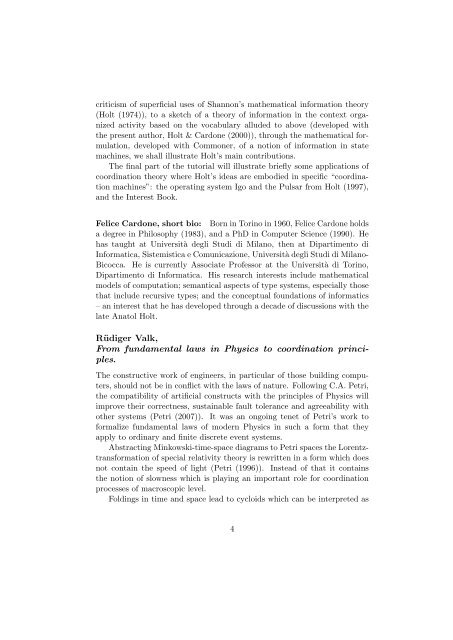Nets, Physics and Coordination - Models of Concurrency ...
Nets, Physics and Coordination - Models of Concurrency ...
Nets, Physics and Coordination - Models of Concurrency ...
You also want an ePaper? Increase the reach of your titles
YUMPU automatically turns print PDFs into web optimized ePapers that Google loves.
criticism <strong>of</strong> superficial uses <strong>of</strong> Shannon’s mathematical information theory(Holt (1974)), to a sketch <strong>of</strong> a theory <strong>of</strong> information in the context organizedactivity based on the vocabulary alluded to above (developed withthe present author, Holt & Cardone (2000)), through the mathematical formulation,developed with Commoner, <strong>of</strong> a notion <strong>of</strong> information in statemachines, we shall illustrate Holt’s main contributions.The final part <strong>of</strong> the tutorial will illustrate briefly some applications <strong>of</strong>coordination theory where Holt’s ideas are embodied in specific “coordinationmachines”: the operating system Igo <strong>and</strong> the Pulsar from Holt (1997),<strong>and</strong> the Interest Book.Felice Cardone, short bio: Born in Torino in 1960, Felice Cardone holdsa degree in Philosophy (1983), <strong>and</strong> a PhD in Computer Science (1990). Hehas taught at Università degli Studi di Milano, then at Dipartimento diInformatica, Sistemistica e Comunicazione, Università degli Studi di Milano-Bicocca. He is currently Associate Pr<strong>of</strong>essor at the Università di Torino,Dipartimento di Informatica. His research interests include mathematicalmodels <strong>of</strong> computation; semantical aspects <strong>of</strong> type systems, especially thosethat include recursive types; <strong>and</strong> the conceptual foundations <strong>of</strong> informatics– an interest that he has developed through a decade <strong>of</strong> discussions with thelate Anatol Holt.Rüdiger Valk,From fundamental laws in <strong>Physics</strong> to coordination principles.The constructive work <strong>of</strong> engineers, in particular <strong>of</strong> those building computers,should not be in conflict with the laws <strong>of</strong> nature. Following C.A. Petri,the compatibility <strong>of</strong> artificial constructs with the principles <strong>of</strong> <strong>Physics</strong> willimprove their correctness, sustainable fault tolerance <strong>and</strong> agreeability withother systems (Petri (2007)). It was an ongoing tenet <strong>of</strong> Petri’s work t<strong>of</strong>ormalize fundamental laws <strong>of</strong> modern <strong>Physics</strong> in such a form that theyapply to ordinary <strong>and</strong> finite discrete event systems.Abstracting Minkowski-time-space diagrams to Petri spaces the Lorentztransformation<strong>of</strong> special relativity theory is rewritten in a form which doesnot contain the speed <strong>of</strong> light (Petri (1996)). Instead <strong>of</strong> that it containsthe notion <strong>of</strong> slowness which is playing an important role for coordinationprocesses <strong>of</strong> macroscopic level.Foldings in time <strong>and</strong> space lead to cycloids which can be interpreted as4
















